I'd laugh if a "DEFEAT" flashed on-screen after the Germans' losing three dreadnoughts to a British cruiser.
The Great War (mod 1914)
- Thread starter Kurt_Steiner
- Start date
-
We have updated our Community Code of Conduct. Please read through the new rules for the forum that are an integral part of Paradox Interactive’s User Agreement.
You are using an out of date browser. It may not display this or other websites correctly.
You should upgrade or use an alternative browser.
You should upgrade or use an alternative browser.
Chapter fifty-two: The battle of Jutland - the action of Cramorty Firth (2)
At about 15:31 pm, Scheer moved within range of Jellicoe's vanguard. At first, visibility favoured the British: HMS Indomitable hit the German battleship König two times, while the heavy cruiser SMS Friederich Karl quickly took 10 hits from HMS Agincourt and sunk with ten minutes with nearly her entire crew going down with their ship. But at 15:40 pm, it was the turn of the Germans to hit their enemies and the light cruiser Roxburg became the target of the battleship Lützow and the battlecruiser Derfflinger. The two German ships then fired three salvoes each at Roxburg, and sank her with all hands in 50 seconds. Then, Scheer's luck vanished.
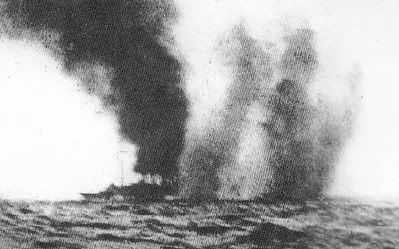
The light cruiser HMS Roxburg is barely visible among shell splashes.
By 16:10 pm Jellicoe effectively crossed "Scheer's T" and the leading German battleships found themselves facing the massed firepower of the entire Grand Fleet main battle line. Thus, Jellicoe's flagship Iron Duke quickly scored seven hits on the lead German dreadnought, SMS König, dooming her. However, in this brief exchange, which lasted only minutes, as few as 10 of the Grand Fleet's 24 dreadnoughts actually opened fire. The Germans were hampered by poor visibility, in addition to being in an unfavourable tactical position, just as Jellicoe had intended. Realizing he was heading into a death trap, Scheer ordered his fleet to turn at 16:30 pm. Under a screen of smoke and mist, Scheer's forces succeeded in disengaging by an expertly executed 180° turn in unison, a well-practiced emergency manoeuvre of the High Seas Fleet. By then, however, the British fire had inflicted a heavy toll on the German line and even Scheer's flagship, SMS Wilhelm der Grosse, was repeatedly hit. The German admiral had to abandon the ship and transfer his flag to a light cruiser as the battleship began to slip beneath the waves.
Then, to win time, the German destroyers attempted a torpedo attack against the Grand Fleet, making Jellicoe to turn away from the battered German line and ending its punishment. In adittion to Scheer's ship, another two German battleships had been sunk -König and Brandenburg- and three more were severely damaged along with one battlecruiser and two heavy cruisers. With Jellicoe following him, Scheer ordered to turn south. However, by 17:15 pm Jellicoe crossed Scheer's "T" again, although this time firing against the tail of the German Fleet. The fire was deadly, causing severe damage to the German battleships (SMS Kronprinz, SMS Kaiserin, Lothringen, Markgraf and Kaiser Willhem II were all hit), while on the British side, the battleship HMS Monarch was hit twice by the German fire and HMS Vanguard was struck by the blows of Hindenburg and forced to leave the British battleline.

The Seydlitz was barely afloat by the ending of the battle. Only extesnive counter-flooding kept her from capsizing. With barely a gun still in action, she limped home alone, observed by several unenterprising British captains. Her survival was testimony to the strenght of ther construction and an exceptionally well-trained crew.
Scheer ordered again his destroyers to launch a torpedo attack on the Grand Fleet, which forced Jellicoe to momentarily turn away, giving thus some respite to the German fleet. Jellicoe was trully amazed by the fact that the Hochseeflotte was still sailing in good order given the punishment received by its ships, as the German dreadnoughts still formed in line and evidently determined to reach home at any cost. He could not know that the Hochseeflotte was on the brink of total destruction. Unsure whether his fleet could last until the night, Scheer decided to gamble, and, at 18:05 pm, ordered Bödicker to lead his battlecruisers against the enemy battleline to give the dreadnoughts some more time. He hoisted the command to a startled Bödicker, who felt that he was going to rehearse a naval version of Balaclava. Furthermore, Scheer ordered another torpedo attack. As the destroyers went forward, Bödicker drove his battered ships towards the nearest adversary, that, by sheer luck, was the Second Battle Squadron, which sailed right behind the First Battle Squadron, which was now heading Jellicoe’s line. Almost simultaneously, Iron Duke, Orion, Monarch, Dreadnought, Thunderer, Erin and Conqueror opened fire on the charging battlecruisers. Thirteen (343 mm) and twelve (305 mm) inch shells were sprayed over the German ships as they rushed headlong towards the British. Repeated salvoes struck the turrets of Moltke and von der Tann, which trembled with the hits while answering to the British cannonade in kind. The torpedo attack was less precise than the previous one, but it was enough to compel Jellicoe to alter the course a bit. Then, at 18:45 pm Bödicker escaped with all haste from the scene of battle, but for the two of his ships that were on the verge of sinking. He successfully avoided the enthusiastic British gunfire. Inflicting a considerable stopping blow, the battlecruisers had landed a number of important hits on Monarch, Dreadnought and Conqueror.
The rest of the Hochseeflotte continued its journey and Scheer hoped that he had won enough time to survive until night time. The dying light made the fate of Bödicker an uncertain one to Scheer, on board the Bayern. As darkness began to slowly grow, after the concerted destroyer and battlecruiser attack a safe gap had emerged between the Grand Fleet and Hochseeflotte. Jellicoe was frustrated that after a day of attacking the Hochseeflotte most of the stubborn vessels of the German Navy had yet to sink, although he had sunk three battleships and one heavy cruiser in exchange for a light cruiser. It was obvious that many enemy ships were evidently wrecked, but this time the British could not rely on weather to repeat the annihilation of the enemy, as it happened with the Armada.
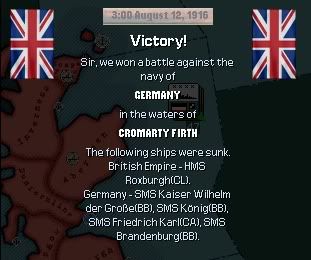
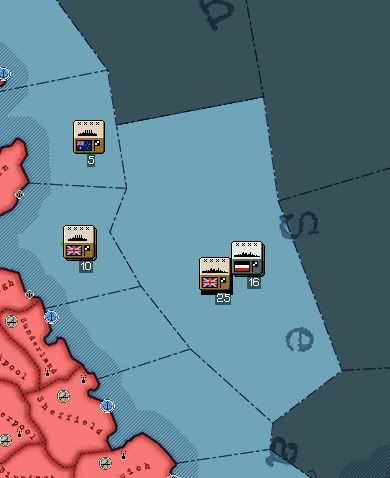
The Hochseeflotte trying to evade the Grand Fleet.
@SirCliveWolfe: Yes, the Grand Fleet is going its bit. And more is still to come...
@quaazi: To those who are being hit by ger guns, the name is too well suited
@trekaddict: I wonder what you'll be doing after this update and, specially, about the next one...
@Enewald: Yes, they did.
@MastahCheef: I wouldn't laugh. I'll just kill the IA.
@Nathan Madien: That's because Trekkie is alternatively possesed by Churchill and Nelson's spirit.
@c0d5579:Old habits die hard.
@Zhuge Liang: After this battle, they won't have so many, trust me
Last edited:
Hooray! Hooray!

No "Tactical draw but strategic Victory" this time. Either way, the bulk of the HSF is going to be out of action for the remainder.
Nelson approves.


No "Tactical draw but strategic Victory" this time. Either way, the bulk of the HSF is going to be out of action for the remainder.
Nelson approves.

The fire was deadly, causing severe damage... Kaiser Willhem III [was] hit...
Holy shit, he's not just bringing Germany out of the Weimar era, he's traveling time now!
Apparently I need to get back to work on Siegerkranz to keep the playboy Kaiser from getting bored and delivering battleships by TARDIS.
I knew that I was right when I told Kurty that he shouldn't study anything related with maths...
HUZARR!!
All that is left now is for the final encounter, leaving the HSF destroyed and a dying Jelicoe to truly encompas a British victory!
HUZARR!! for the Grand fleet, HUZARR!! for Jelicoe and HUZARR!! for Nelson
Interestingly this should mean that, post war, the British/Imperial peoples will be much more behind the continuation of the RN's build up... as opposed to the decline in interest IOTL.
HUZARR!! HUZARR!! HUZARR!!
All that is left now is for the final encounter, leaving the HSF destroyed and a dying Jelicoe to truly encompas a British victory!
HUZARR!! for the Grand fleet, HUZARR!! for Jelicoe and HUZARR!! for Nelson
Interestingly this should mean that, post war, the British/Imperial peoples will be much more behind the continuation of the RN's build up... as opposed to the decline in interest IOTL.
HUZARR!! HUZARR!! HUZARR!!
Surely even this AAR's Germany must recognise a naval defeat when it sees one- will finally be the last we see of the HSF?
Chapter fifty-three: The battle of Jutland - Dogger Bank
The Grand Fleet was in cruising formation, the Hochseeflotte to its south, visibly dishevelled in formation after the intense day of fighting. Scheer sought to put as much distance between the fleets during the evening to allow a reasonable margin of safety in the morning. Consequently, he ordered his bedraggled ships to the rear of the line, as the damage inflicted by Jellicoe’s guns had impaired their speed considerably. The German commander also possessed an ace up his sleeve. Located due east was a batch of U-boats, and Scheer was aware of their whereabouts. By drawing the Grand Fleet towards them, he reasoned that he might still escape and cause serious damage to the British.
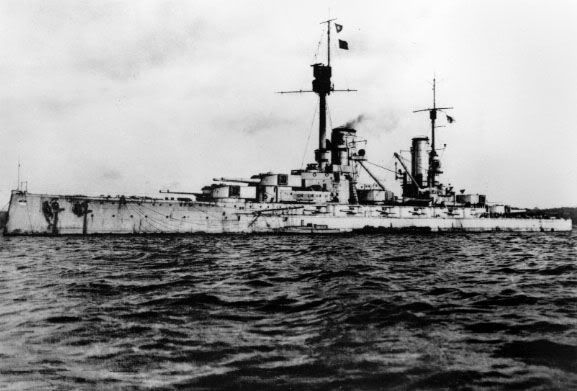
The battleships SMS Markgraff, the third battleship of the four-ship König class, had been commissioned into the Imperial Navy on 1 October 1914, just over two months after the outbreak of war in Europe. Armed with ten 12 inch (305 mm) guns in five twin turrets, she could steam at a top speed of 21 knots.
At 19:25pm, the battleship SMS Markgraff sucumbed to the damage received. She rolled over to port, her magazines exploded and the ship sank quickly. Similarly, another two battleships abandoned the German line (Lothringen and Kaiserin), too damaged to follow the rest of the fleet -they would be later sunk by British destroyers. Thus Scheer took a dramatic decision. Hampered by his obsolete pre-dreadnoughts, which were struggling to keep pace with the main body of the Hochseeflotte, he attempted to deliver a stopping blow to the Grand Fleet. Scheer ordered the pre-dreadnoughts Deutschland, Schlesien, Schleswig-Holstein and Hannover and the heavy cruisers Beowulf, Gneisenau, Blücher and Scharnhorst to change course northwards and cut across the path of the Grand Fleet at 20:15 pm. In an attempt to save the Hochseeflotte, Scheer was prepared to sacrifice his weakest vessels, which turned towards the jaws of death in what became known as the "death ride". Even Jellicoe was astonished by this move and was slightly slow to react, which allowed the enemy pre-dreadnoughts to be the first to open fire.
Turning south-southwest to allow a full broadside from all the battleships in the line, Jellicoe tried not to loose track of the enemy main force while the German pre-dreadnoughts braced themselves for the ensuing storm, which soon fell upon them. A terrific cannonade was directed at once upon the intrepid pre-dreadnoughts. Then, against all logic, these vessels, already damaged and subjected to devastating gunfire, sailed through the storm of steel – decks were ablaze, superstructures wrecked beyond recognition and with hundreds of dead sailors on their decks- and left behind the enemy fleet. Then, as the last German ship had vanished in darkness, night was made day by a terrible fireball when, at 21:22 pm, Beowulf exploded in a terrible fireball, momentarily lit up the night’s sky and vanished in seconds. Three minutes later, at 21:25pm, Scharnhorst fired its last round in defiance and then began to sunk slowly.
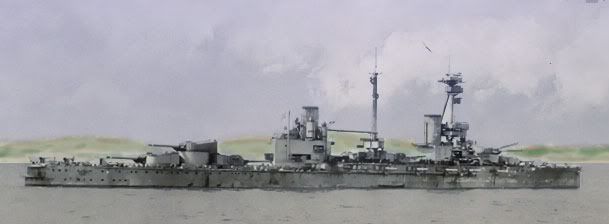
HMS Agincourt had been originally commissioned by Brazil, but the collapse of the rubber boom plus a lessening of the rivalry with Argentina led to her resale while still under construction to the Ottoman Empire who renamed her as Sultan Osman I. Then, with completion just as the war began, she was seized for use by the Royal Navy, an act which contributed to the decision of the Ottoman Empire to support Germany in the war.
As dusk turned to night, Jellicoe decided to keep his fleet at a safe distance from the Hochseeflotte. Aware that German destroyers and submarines remained a potential threat, he was unwilling to endanger his fleet to a torpedo attack that could be hard to detect in the midst of darkness. Preservation remained his chief objective. Jellicoe knew the futility of pursuing a broken force and changed course accordingly while the Hochseeflotte became a mere shadow in the distance. Knowing that perhaps been leading to a ambush by the dangerous German Uboaten, he turned north and abandoned the persecution.
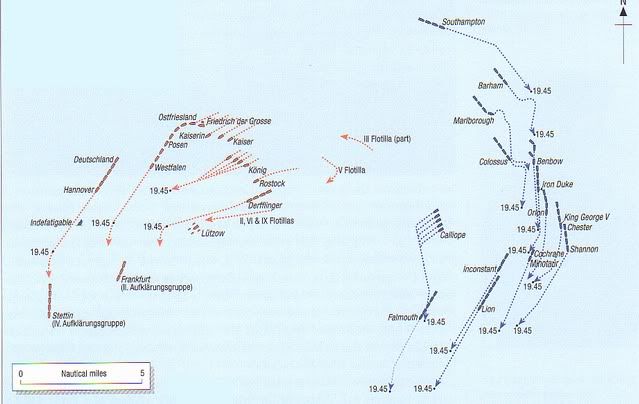
The situation of the two naval forces prior to the change of course of the Grand Fleet.
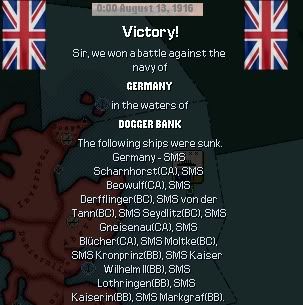
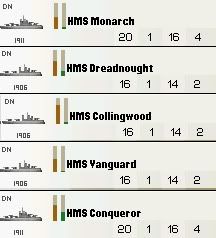
The Hochseeflotte had suffered the loss of four dreadnoughts, four pre-dreadnoughts, four battlecruisers, five cruisers and fifteen destroyers (with a total tonage of 139,200) and lost 5,523 sailors . Most of its remaining ships were little more than floating wreckages. In particular, the battleship Thuringen and the heavy cruiser Blücher barely above the waterline. At all effects, Jellicoe had destroyed the Hochseeflotte and had reduced it to a naval nonentity for the foreseeable future. The Grand Fleet, having lost just one light cruiser and eight destroyers (plus three battlecruisers and two armoured cruisers damaged), reached Scapa Flow without problems (1). News spread that a great battle at sea had been fought and there was extensive speculation about its outcome, but as soon the War Cabinet received the full account of the battle, by some unknown mistake, it was "leaked" to the press. Finally Asquith had achieved a first substantial victory over German arms.
(1) I must confess that I'm ashamed of having suffered so little.
@trekaddict: I do wonder what are you going to say now.
@quaaz: Are you still rooting for them?
@Agent Larkin: From time to time she does
@c0d5579: Yes, do hurry and bring back TARDIS to Dr. Who!
@PetiNiebla: Too true... too true...
@Enewald: We hit everything, sir!
@SirCliveWolfe: Jelicoe... no, he is not going to die. He has to deal with Beatty first.
@MastahCheef117: Yes, that was I thought... until I saw the result of the battle here narrated
@Nathan Madien: Thank you! It's the result of reading some descriptions of several WW1 naval battles and getting the spirit, because, honestly, I'm not a sailor.
@Zhuge Liang: I'm sure that the do now and, without spoiling the AAR too much, this is the last we see of the German surface fleet.
Last edited:
Congratulations Kurt!
The HSF is defeated, now surely The Grand Fleet can go and obliterate those Ottoman forst
In all seriousnes though, can they not be used the fire upon German positions near the coast in Belgium? Or will we now see a landing at Keil?
The HSF is defeated, now surely The Grand Fleet can go and obliterate those Ottoman forst
In all seriousnes though, can they not be used the fire upon German positions near the coast in Belgium? Or will we now see a landing at Keil?

Rule Britannia indeed!
Also, did the mighty Warspite sink anything and was her steering damaged?
That was decisive in a way that even Midway wasn't. The closest OTL comparison I can find is Leyte Gulf, or possibly the Nile.
That was decisive in a way that even Midway wasn't. The closest OTL comparison I can find is Leyte Gulf, or possibly the Nile.
Methinks that ITTL the British would prefer the Nile. Not quite Trafalgar though...

